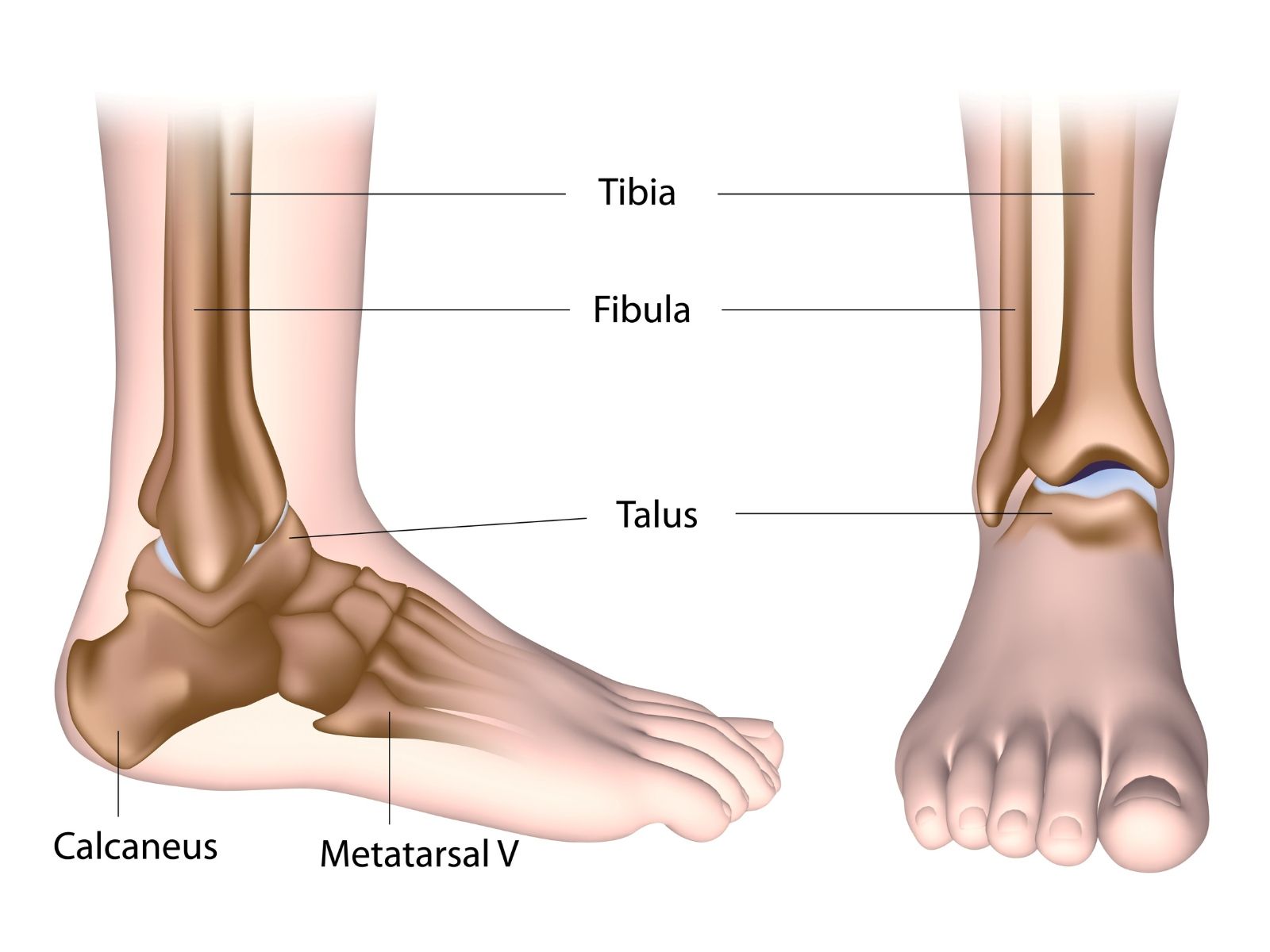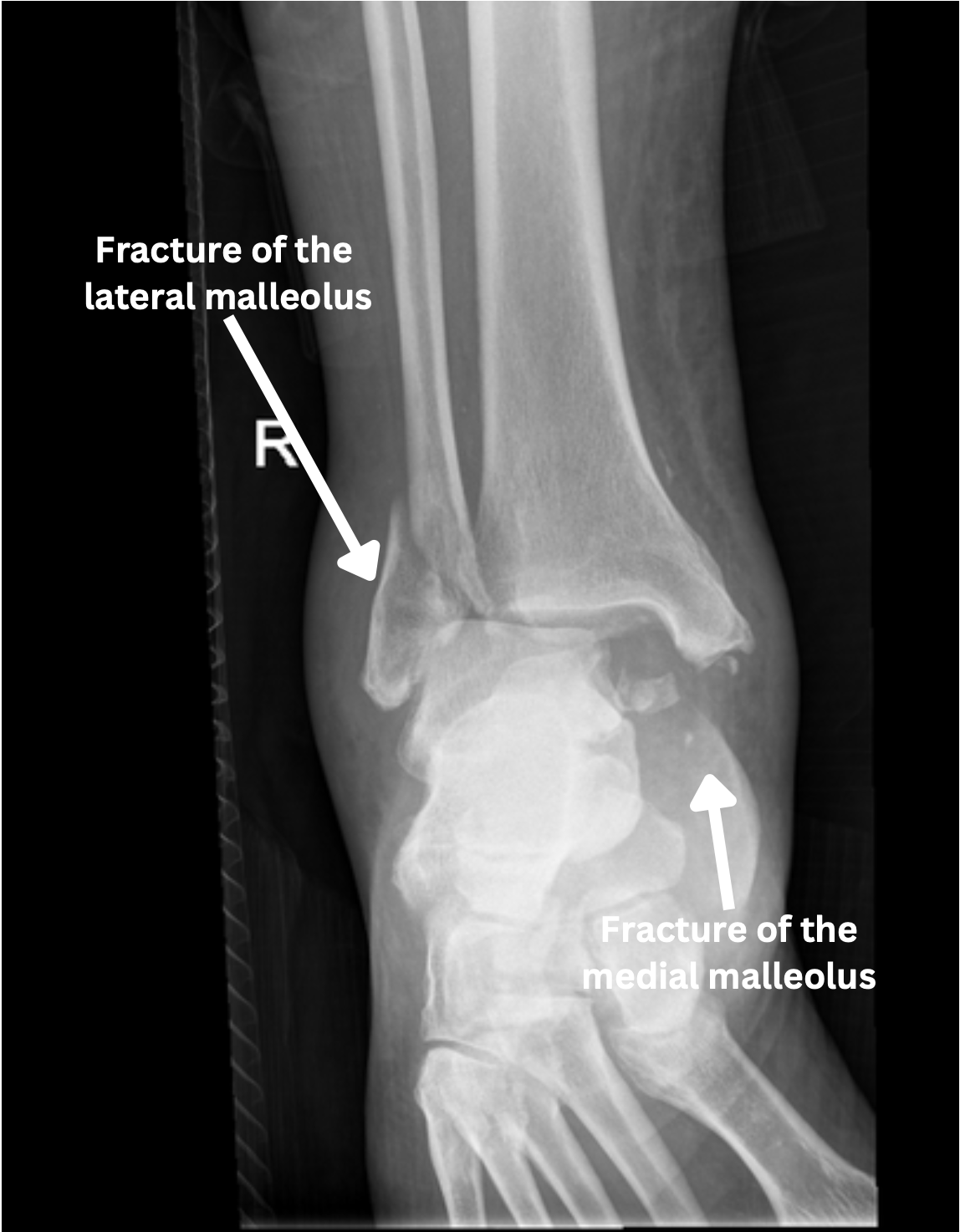Ankle Fractures
What is an Ankle Fracture?
The ankle joint is a complex structure that plays an important role in supporting body weight and enabling movement. It comprises three bones, several ligaments, and tendons that provide stability and mobility. The three bones are the tibia (shinbone), the fibula (outside calf bone) and the talus (bone that connects the leg to the foot). An ankle fracture, more commonly known as a broken ankle, is an injury that occurs when one or more of the bones that make up the ankle joint, break. These injuries can range from stable breaks that can be treated with a moon boot to life-changing fracture dislocations that take months and/or years of rehabilitation.


Impact of Ankle Fractures on Anatomy and Health
Ankle fractures disrupt the stability and function of the ankle joint, leading to:
- Pain and Swelling: Immediate discomfort and inflammation around the fracture.
- Loss of Mobility: Difficulty bearing weight or moving the ankle.
- Joint Instability: Damaged bones or ligaments can weaken the ankle's ability to support the body.
- Long-term Effects: If not properly treated, ankle fractures can lead to arthritis, chronic pain, or permanent deformities.
Risk Factors for Ankle Fractures
Some factors that may increase the risk of an ankle fracture include:
- Participation in high-impact sports
- High forces through the ankle joint
- Osteoporosis or weak bones, advanced age
- Being overweight
- Excessive alcohol intake
- Smoking
Causes of Ankle Fractures
Ankle fractures can occur with:
- A sudden twist or roll of the ankle, often occurring during sports activities.
- Direct impact to the ankle, such as from a fall or collision
- Missteps on uneven surfaces or stairs
Symptoms of an Ankle Fracture
Individuals who experience an ankle fracture may have the following symptoms:
- Sudden and severe pain
- Swelling and bruising
- Inability to bear weight on the affected ankle
- Deformity or visible bone protrusion
- Limited range of movement
Prevention of Ankle Fractures
Preventing ankle fractures involves strengthening bones and avoiding high-risk situations:
- Maintain Bone Health:
- Eat a diet rich in calcium and vitamin D.
- Engage in weight-bearing exercises to strengthen bones.
- Use Proper Gear:
- Wear supportive shoes that fit well.
- Use ankle braces during high-risk activities or sports.
- Improve Balance:
- Practice exercises like yoga or balance training.
- Avoid High-Risk Activities:
- Be cautious when walking on uneven surfaces or in slippery conditions.
- Stay Active:
- Regular exercise helps improve joint strength and flexibility.
- Address Health Conditions:
- Treat osteoporosis or other conditions that may weaken bones.
Types of Ankle Fractures
Ankle fractures can be classified into various types depending on their location:
- Lateral malleolus fracture: A fracture of the fibula near the ankle joint on the outer side of the ankle.
- Medial malleolus fracture: A tibia fracture near the ankle joint on the inner side of the ankle.
- Posterior malleolus fracture: A fracture of the back part of the ankle joint.
- Bimalleolar fracture: A fracture involving both the lateral and medial malleoli, which often results in an unstable ankle and requires emergency surgery

- Trimalleolar fracture: A fracture involving the lateral and medial malleoli and the posterior malleolus. This type of fracture is usually more severe and requires surgical intervention.
- Talus fracture: A fracture of the talus bone, which can range from minor to severe.
- Avulsion fracture: A fracture where a small piece of bone is pulled away from the main bone by a ligament or tendon
- Syndesmosis injury: The syndesmosis is the strong joint that joints the tibia and the fibula at the level of the ankle joint (see Syndesmosis Injuries Information Sheet)
Stages of Ankle Fractures
The healing process of an ankle fracture can be divided into three stages:
- Inflammatory Stage (First few days):
- Blood clots form around the fracture.
- The area becomes swollen and painful.
- Reparative Stage (2-6 weeks):
- New bone tissue (callus) starts forming to bridge the fracture.
- Swelling may decrease, and the fracture begins to stabilise.
- Remodeling Stage (6 weeks to several months):
- Bone tissue strengthens and reshapes.
- Normal bone structure is restored, and function improves.
Diagnosis of Ankle Fractures
Imaging tests, such as X-rays, CT scans, or MRIs, may be ordered to confirm the diagnosis, assess the severity or extent of the fracture, and identify possible associated injuries. These tests can also help with pre-operative planning.
Treatment of Ankle Fractures
The treatment of an ankle fracture depends on the type and severity of the injury. Treatment options include non-surgical and surgical approaches.
Non-Surgical Treatment:
- Immobilisation: A cast, splint, or boot may be used to immobilise the ankle, allowing the bones to heal properly.
- Medication: Over-the-counter or prescription pain relievers and anti-inflammatory medications may be prescribed to alleviate pain and reduce swelling.
- Elevation and ice: Elevating the injured ankle and applying ice can help minimise swelling and discomfort.
- Physiotherapy: Once the fracture has healed, a physiotherapist may recommend exercises and stretches to restore strength, flexibility, and range of movement.
Surgical Treatment:
In cases of severe or displaced fractures, surgery may be necessary to realign the bones and secure them with screws, plates, or other hardware. (See Ankle Fracture Surgery Information Sheet)
What if Ankle Fractures Are Untreated?
Leaving an ankle fracture untreated can lead to several complications:
- Chronic Pain: Persistent pain due to improper healing.
- Joint Instability: Weakness or wobbliness in the ankle joint.
- Deformity: Misaligned bones can cause abnormal walking patterns.
- Post-Traumatic Arthritis: Early-onset arthritis in the ankle joint.
- Infection: Open fractures may develop infections without prompt care.
- Permanent Disability: Inability to bear weight or loss of full ankle function.
Prompt diagnosis and treatment ensure proper healing and prevent long-term complications.
If you have any concerns or questions regarding ankle fractures or have recently injured your ankle and require review, please contact us and book an appointment with Dr Graff.
Useful Website
